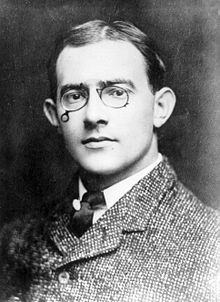Notes

Carl Graham Fisher.
Photo from Wikipedia
From Wikipedia:
"Carl Graham Fisher (January 12, 1874 – July 15, 1939) was an American entrepreneur. Despite having severe astigmatism, he became a seemingly tireless pioneer and promoter of the automotive, auto racing, and real estate development industries. He is widely regarded as a promotional genius.
"Despite family financial strains and a disability, in the late 19th century, he became a bicycle enthusiast and opened a modest bicycle shop with a brother. An Indiana native, he also became involved in bicycle racing and later many activities related to the emerging U.S. auto industry in the early 20th century. In 1904, Carl Fisher and his friend James A. Allison bought an interest in the U.S. patent to manufacture acetylene headlights, a precursor to electric models which became common about 10 years later. Soon Fisher's firm supplied nearly every headlamp used on automobiles in the United States as manufacturing plants were built all over the country to supply the demand. The headlight patent made him rich as an automotive parts supplier and he and Allison cashed out when they sold their company, Prest-O-Lite, to Union Carbide in 1913 for $9,000,000.
"Fisher operated what is believed to be the first automobile dealership in the United States in Indianapolis, and also worked at developing an automobile racetrack locally. After being injured in stunts himself, and following a safety debacle at the new Indianapolis Motor Speedway, of which he was a principal, he helped develop paved racetracks and public roadways. Improvements he implemented at the speedway led to its nickname 'The Brickyard'.
"In 1913, Fisher conceived and helped develop the Lincoln Highway, the first road for the automobile across the entire United States of America. A convoy trip a few years later by the U.S. Army along Fisher's Lincoln Highway was a major influence upon then Lt. Col. Dwight D. Eisenhower years later in championing the Interstate Highway System during his presidency in the 1950s.
"Carl Fisher followed the east-west Lincoln Highway in 1914 with the conception of the north-south Dixie Highway, which first led from Indianapolis, and eventually extended in several northern branches from the Mid-West U.S. at the Canadian borders to southern mainland Florida. Under his leadership, the initial portion was completed within a single year, and he led an automobile caravan to Florida from Indiana.
"At the south end of the Dixie Highway in Miami, Florida, Fisher became involved in the successful real estate development of the new resort city of Miami Beach, built on a largely unpopulated barrier island and reached by the new Collins Bridge across Biscayne Bay directly at the terminus of the Dixie Highway. Fisher was one of the best known and active promoters of the Florida land boom of the 1920s. By 1926, he was worth an estimated $100 million, and redirected his promotional efforts when the Florida real estate market bubble burst after 1925. His final major project, cut short by the Great Depression, was a 'Miami Beach of the north' at Montauk, located at the eastern tip of Long Island, New York.
"His fortune was lost in the Stock Market Crash of 1929 and the Great Depression in the United States which followed shortly thereafter. He found himself living in a small cottage in Miami Beach, doing minor work for old friends. Nevertheless, years after his fortune had been lost, at the end of his career, he took on one more project, albeit more modest than many of his past ventures, and built the famous Caribbean Club on Key Largo, intended as a 'poor man's retreat.'
"Although he had lost his fortune and late in life considered himself a failure, Fisher is widely regarded as a very successful man in the long view of his life. He was inducted into the Automotive Hall of Fame in 1971. In a 1998 study judged by a panel of 56 historians, writers, and others, Carl G. Fisher was named one of the 50 Most Influential People in the history of the State of Florida by The Ledger newspaper. PBS labeled him 'Mr. Miami Beach.' Just south of Miami Beach, Fisher Island (which he once owned, and is named for him), became one of the wealthiest and most exclusive residential areas in the United States."

